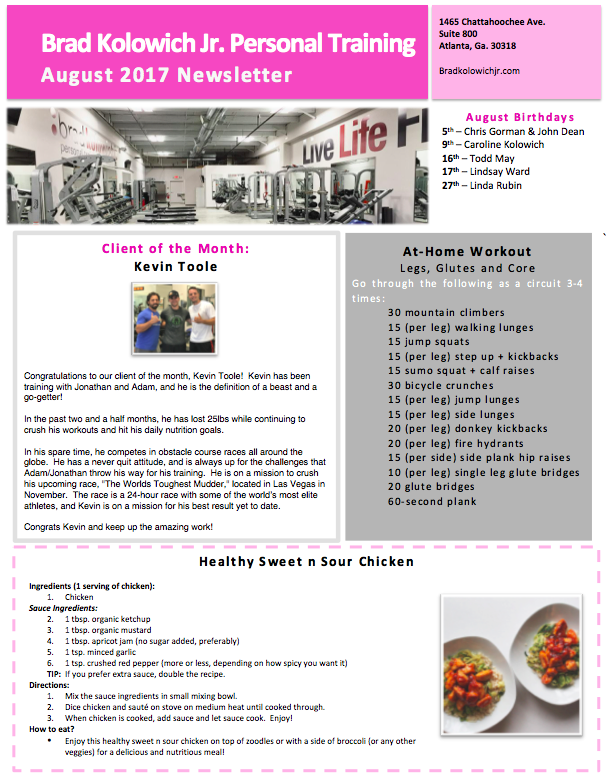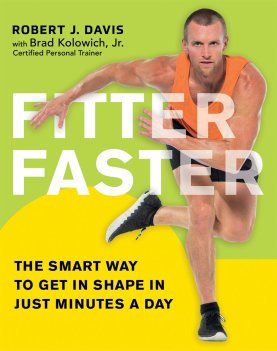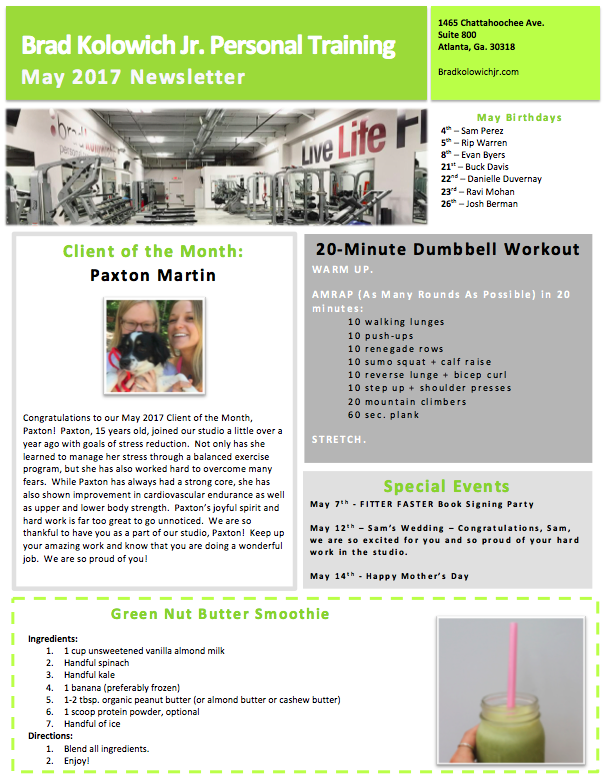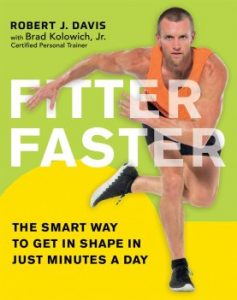Posts
For more on Fitter Faster: The Smart Way to Get in Shape in Just Minutes a Day, check out FitterFasterPlan.com!
Enjoy!
Make sure to check out this amazing article below, The Sneakiest Strength Exercises to Do at Your Desk, by Elizabeth Millard, adapted from MyFitnessPal.
The Sneakiest Strength Exercises to Do at Your Desk
By Elizabeth Millard
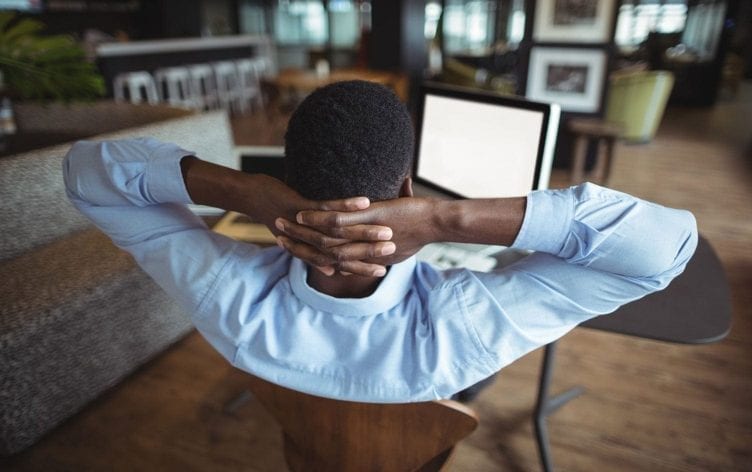
Picture adapted from MyFitnessPal
In many workplaces, being sedentary is the default. Even with standing desks, parking at the other end of the lot, walking to meetings and trying to walk at lunch, most people still spend the majority of their workdays sitting.
Fortunately, there’s a way to sneak muscle-building exercises into your 9–5 — even if your day is packed with meetings. The trick is using isometrics — moves that use contraction and relaxation to engage muscles.
HOW ISOMETRIC EXERCISES WORK
On a basic level, muscles contract in three main ways. Concentric contraction happens when a muscle tenses as you’re shortening it. Eccentric contraction occurs when that muscle tension is prompted through lengthening — such as resistance or lowering a weight.
For example, with a bicep curl, you’d have concentric action as you bring the weight toward you, and eccentric contraction as you lower the weight.
With isometric contraction, muscles tighten without changing length, and there is no movement in a joint, according to Australian-based strength and conditioning coach Andrew Read. He notes that examples include pushing against an immoveable object like a wall or holding plank pose — you’re in one position without movement, but still doing plenty of work.
Sometimes called “static strength training,” isometric exercises can be so effective they bring muscles to fatigue quickly, Read says. The effects last long after they’re done. “Isometrics work, just use them like any other high-intensity method,” Read says. “A little goes a long way.”
TARGETED MOVES
Try peppering these isometric exercises into your workday. Although they seem like modest moves, they can help to keep your muscles working:
HAND PRESS
Clasp your hands or press your palms together in front of your chest, elbows bent, exerting equal pressure in both arms. Hold each press for 10 seconds, then release. Repeat 5–6 times. This will work your biceps, chest and triceps — perhaps while you’re reading emails
AB HOLD
Sit up straight in your chair, with shoulders relaxed. Breathe deeply and engage your abs as if you’re bracing for a punch. Hold for 5 seconds, then breathe out while “crunching” your abs upward as if you’re doing a sit-up. Exhale completely, take a few breaths, then repeat. This can be an especially good exercise during boring meetings, since the action is subtle and no one will know you’re doing a major ab workout while you’re taking notes.
GLUTE SQUEEZE
Strong glutes help to protect your back, especially when you’re chair-bound for most of the day. A simple isometric exercise is to squeeze your glutes and hold the contraction for 10 seconds, then release.
WALL PRESS
To get some movement in your shoulders and engage your core, stand about 3 feet from a wall and place your palms against it at shoulder height and width apart. Press firmly against the wall for 10 seconds, then release. You can also make this into a push-up by lowering your torso toward the wall and pressing back up.
PUTTING ISOMETRICS TO WORK
Keep in mind that the main benefit you’ll see is stabilization of the muscles, according to Edward Laskowski, MD, of the Mayo Clinic. “Since isometric exercises are done in a static position, they won’t help improve speed or athletic performance,” he says. “Isometric exercises don’t effectively build strength but can help maintain muscle strength.”
He adds that isometrics are often used in physical therapy to rehab injured muscles, so if you’re trying to bounce back after injury or other issues, putting some isometric exercises into your everyday schedule can be useful.
There’s also another advantage, especially for work: Isometric exercises can help lower blood pressure, Laskowski notes. That means you might de-stress and sneak in some workout moves at the same time.
Read’s recommendation is to incorporate a few exercises per day, and do them at about 30% of your max effort. From there, you can start to build more into your workdays and increase intensity over time.
Adapted from http://blog.myfitnesspal.com/sneakiest-strength-exercises-desk/
Some people do aerobic exercise first thing, before they’ve eaten, because they think it will help them burn more fat. There is some evidence that this practice, sometimes called “fasted cardio,” may boost fat burning — but only fleetingly. Over the course of days or weeks (which is what counts), research shows that it doesn’t seem to offer any advantages. For example, in a four-week trial that randomly assigned young women to either fast or drink a 250-calorie shake before their aerobic workouts (while otherwise eating a low-calorie diet), both groups lost the same amount of fat and weight. Similarly, a study involving overweight women who did high-intensity interval workouts for six weeks after either fasting or eating found no differences in fat loss.
All in all, the best time to work out is whenever you can. If you exercise at different times of the day, be sure to note the hour as you’re tracking your progress. That way, you’ll know when your body clock may be to blame for a less-than-optimal workout.
— Robert J. Davis
Adapted from “Fitter Faster: The Smart Way to Get in Shape in Just Minutes a Day.”
Adapted from https://www.washingtonpost.com/national/health-science/what-is-the-best-time-of-day-to-exercise-its-not-when-you-think/2017/06/16/2020c3ba-51cf-11e7-be25-3a519335381c_story.html?utm_term=.65bc4f5ef6f2
By Robert J. Davis, Special to CNN
(CNN) – For some people, summer is the time to head indoors to exercise. But others welcome the heat as a way to sweat more and get a better workout.
Indeed, I’ve long regarded the sweatiness of my exercise sessions as a sign of how hard I was pushing myself. But it turns out I’ve been wrong: How much you sweat doesn’t necessarily correlate with how intense your workout is or how many calories you burn.
When your body temperature rises, your eccrine glands secrete sweat, and the evaporation of moisture from your skin helps you cool off. Of course, sweating can occur for other reasons, such as stress or fear.
That type of sweat comes from the apocrine glands, which are located mainly in the underarm and groin.
How much we sweat during exercise is due to a number of factors, including gender (men tend to sweat more than women) and age (younger people sweat more than older people) as well as genetics, temperature and humidity.
Weight plays a role as well. Larger people tend to sweat more, because their bodies generate more heat.
Another contributor is fitness level. Surprisingly, fit people tend to sweat sooner during exercise and more copiously than those who are less fit.
Research suggests that as your fitness level improves, your body’s heat-regulating system becomes more efficient, cooling you down faster and allowing you to work harder.
Don’t be misled by the loss of a few pounds after a high-sweat workout. This is simply water weight that you gain back when you rehydrate and doesn’t necessarily mean you’ve burned lots of calories.
On the flip side, don’t assume that a low-sweat workout means you aren’t working hard enough or burning enough calories. It could be that your sweat evaporates quickly because you’re exercising in air-conditioning, near a fan or outdoors on a windy day. Or, unlike me, you simply may not sweat much.
Whatever the case, wearing clothing made of synthetic fabrics such as polyester or Lycra can help you feel less sweaty. These pull (or wick) sweat from your skin to outer layers of the clothes, where the moisture evaporates.
Cotton, on the other hand, absorbs moisture but doesn’t promote evaporation. As a result, your shirt or other clothing can feel soaked and heavy after a workout.
A drawback of polyester is that it tends to stink more than cotton after exercise. In one study, researchers collected the sweaty shirts of 26 subjects after an hour of intensive spinning. The next day, trained sniffers determined that the polyester shirts smelled worse than the cotton ones. (It’s unclear who exactly agreed to do this job or why.)
Micrococci, a type of bacteria that break down sweat and cause unpleasant odor, were found to grow only on the polyester garments. That’s important because sweat itself is generally odor-free; it’s the combination of sweat and certain bacteria that literally raises a stink.
You can find “odor-resistant” synthetic fabrics, which are treated with various antibacterial compounds. Among the most common is silver, typically applied in tiny amounts known as nanoparticles.
But some research suggests that silver-treated clothing may not work as well as promised to reduce bacteria and odor. What’s more, a significant amount of the silver may come out in the wash, reducing the effectiveness of the garments and potentially harming the environment.
There are also concerns that exposing our skin to silver nanoparticles may pose a health risk, though there’s no direct evidence for this.
Adapted from “Fitter Faster: The Smart Way to Get in Shape in Just Minutes a Day” by Robert J. Davis with Brad Kolowich Jr.
Adapted from http://www.cnn.com/2017/06/13/health/sweating-workout-fitness-exercise-davis/index.html
9 Common Myths About Exercise
Exercise advice can be misleading. Here are nine familiar fitness directives that may be unnecessary or even counterproductive.
Stretch beforehand to prevent injuries.
Many of us learned in gym class or little league that static stretching, such as reaching for your toes and holding the stretch, before activity can prevent injury. But research has generally failed to support the idea. What’s more, pre-exercise static stretches may even do harm by impairing performance. One possible reason is that a looser muscle acts like an overstretched slingshot, generating less force than one that’s taut. Another theory is that stretching “cold” muscles damages them.A better approach is to warm up and then do dynamic stretches, such as arm or leg swings, which involve movement. Unlike static stretching, dynamic stretching primes muscles for action and may improve performance. In a study of young and middle-aged men, for example, vertical jump heights increased after dynamic stretching, while they declined after static stretching.Save static stretching for after exercise, when your muscles are warm. Hold each stretch for 20 to 30 seconds. You should feel tightness or slight discomfort, but not pain.
Exercise on an empty stomach to burn more fat.
The rationale behind doing aerobic exercise on an empty stomach, a practice known as “fasted cardio,” is that when carbohydrate stores in the body are depleted, you burn mainly fat. In addition, when insulin levels are low, which is the case when you fast, you burn more fat.Indeed there’s some evidence that fasted cardio may boost fat burning—but only fleetingly. Over the course of days or weeks (which is what counts), research shows that fasted cardio doesn’t offer any advantages. In a four-week trial that randomly assigned young women to either fast or drink a 250-calorie shake before their aerobic workouts, while otherwise eating a low-calorie diet, both groups lost the same amount of fat and weight.Indeed there’s some evidence that fasted cardio may boost fat burning—but only fleetingly. Over the course of days or weeks (which is what counts), research shows that fasted cardio doesn’t offer any advantages. In a four-week trial that randomly assigned young women to either fast or drink a 250-calorie shake before their aerobic workouts, while otherwise eating a low-calorie diet, both groups lost the same amount of fat and weight.
Monitor your heart rate during exercise.
To measure exercise intensity, some programs have people wear heart-rate monitors and stay within a particular zone. Many gyms and cardio machines display charts showing what your target heart rate should be.The problem is that these targets are dependent upon your maximum heart rate (MHR), which is notoriously hard to measure on your own. The conventional way is to subtract your age from 220. But that formula is too simplistic and often yields flawed results, especially in older people. Other formulas have been shown to be lacking as well. If your MHR estimate is off, your target zone will be too high or too low.While people with medical conditions may require a heart-rate monitor during activity, most of us can use a simpler method to gauge intensity: a scale from 1 to 10 that measures how hard you feel your body is working overall. A 5 or 6 indicates moderate intensity, and a 7 or higher means vigorous activity.Perhaps the easiest method is the talk test. If you can talk and sing during your activity without becoming breathless, the intensity level is low. If you can talk but not sing, the intensity is moderate. And if you can say only a few words before having to catch your breath, you’re doing vigorous exercise.
Hold weights when you walk.
Carrying small dumbbells or wearing wrist weights seems, in theory, like a good way to boost the intensity of your walks while also working your upper body. In fact, adding weight does burn more calories. But there’s a problem. The light weights that people often use for walking typically burn too few extra calories to really matter. And heavier weights necessary for meaningful calorie burning may alter your natural arm swing and increase the risk of injuries.A better option may be to walk with poles. The practice, sometimes called Nordic walking or exerstriding, originated in Finland as an off-season training method for cross-country skiers. Research suggests that pole walking works upper body and abdominal muscles, allows you to walk faster and burns more calories than regular walking—all without making you feel as though you’re working harder. In addition, unlike weights, which may put stress on your joints, pole walking takes pressure off your knees, hips and lower back.
Buy running shoes based on your foot type.
Running shoes come in several categories, each designed for a different foot type. Stability shoes are for runners whose feet roll inward excessively or “overpronate” when they land, while motion control shoes are intended for those who have flat feet and are severe overpronators. Neutral shoes are designed for runners with high arches who don’t overpronate or who underpronateFor years it’s been widely assumed that overpronation leads to injuries and that using the right shoe can reduce the risk. But research has called these beliefs into question. In a study of more than 900 novice runners, all were instructed to use the same model of neutral shoes regardless of their foot type. Surprisingly, the runners with overpronated feet experienced fewer injuries than those with neutral feet, even though the overpronators were using the “wrong” shoe.This study comes on the heels of other research showing that assigning shoes based on foot type does not reduce injury risk. While a stability or motion control shoe may be the best choice for some people, your best bet is likely a neutral shoe that’s comfortable.
Drink even when you’re not thirsty.
Conventional wisdom (much of it influenced by makers of sports beverages) asserts that you should “stay ahead of your thirst” before, during and after exercise to avoid dehydration. But studies show that for most people, thirst is a reliable indicator of when you need more fluid, even during exercise.Research suggests that dehydration isn’t always the threat that it’s portrayed to be. Contrary to popular belief, it’s generally not a cause of exercise-related muscle cramps or heat illness. And studies involving competitive cyclists have found that mild dehydration doesn’t impair exercise performance. What’s more, drinking only when thirsty results in better performance than does chugging constantly.Though you want to make sure to consume enough water, especially if you’re older or exercising in the heat, a bigger problem than dehydration may be drinking too much during exercise. If you take in so much fluid that your body can’t get rid of the excess, sodium levels can become dangerously low. The resulting condition, known as hyponatremia or water intoxication, is potentially fatal. To head it off, simply drink when you’re thirsty.
Check the color of your pee to see whether you’re dehydrated.
You’ve likely heard that urine ideally should be pale yellow and that the darker it is, the more you’re dehydrated. It turns out the science behind such guidance isn’t so clear. In a review of the evidence, researchers debunked the notion that urine color is an accurate marker of hydration. Part of the problem is that some foods (such as beets and carrots) can affect the color of urine, as can certain vitamins. Ditto for some medications and dietary supplements. What’s more, striving for pale pee could cause some people to overhydrate themselves during exercise and develop hyponatremia.If you’re concerned that your workout routine is leaving you dehydrated, try weighing yourself without clothes before and after exercise. If you lose up to a few pounds, you’re likely okay. If you lose more than that, you may want to increase your fluid intake. If, on the other hand, you gain weight, you may be drinking too much.
Eat afterward to refuel.
While you’ve probably heard that downing protein within an hour or so after strength training is necessary to maximize gains, the research on this is mixed. The science is even less conclusive on whether eating protein after aerobic exercise is beneficial.Consuming carbohydrates after exercise may help endurance athletes, especially if they have another training session later in the day. Some research suggests that chocolate milk is an ideal recovery food for such athletes because of its ratio of carbohydrates to protein. But for the rest of us who do a typical exercise routine of walking or running for 30 to 60 minutes, there’s generally no need to refuel with chocolate milk or anything else. In fact, if you’re watching your weight, adding calories after your workouts—without reducing them sufficiently elsewhere in your diet—could undermine your efforts.
Avoid sex before competition.
Abstinence from sex has long been considered essential for success in sports. As Rocky Balboa’s trainer put it in the movie Rocky, “women weaken legs.” But research has yielded little support for the belief. One study, which involved former male athletes, measured grip strength the morning after they’d had sex with their wives and then repeated the test after the men had abstained for at least six days. There were no differences in test results.Overall, the research suggests that sex before physical activity doesn’t have negative effects as long as there’s a lag of at least two hours and the sexual activity doesn’t also involve alcohol, drugs or sleep loss. In fact, it’s possible that sex may even enhance athletic performance by helping people relax.It’s unknown whether women are affected differently than men. The impact likely varies from person to person, so if you’re wondering how pre-game sex affects your golf score or your 5K race time, you‘ll need to do your own experiment and see for yourself.Adapted from TIME Health Magazine at http://time.com/4779651/exercise-myths-heart-rate/?xid=homepage
We hope you all enjoyed this amazing article!
Caroline Kolowich
Do you have a job that keeps you sitting at your desk all day? Do you commute for long periods of time? Do you get home and just want to lay in bed and watch some TV?
That’s what life is like for most people in America. We drive to work, sit at our desk all day, drive back home and then sit down to wind down after a long day of work.
Hopefully, somewhere in the midst of all of that you are fitting in some exercise!
I’ve been reading a book called “Fitter Faster” by Health Journalist Robert J Davis and Certified Personal Trainer Brad Kolowich, Jr., which discusses this, and I wanted to share it with you all.
Can Sitting Cancel Out the Benefits of Exercise?
By Robert J. Davis, Ph.D.
Author of Fitter Faster: The Smart Way to Get in Shape in Just Minutes a Day
Adapted from Fitter Faster: The Smart Way to Get in Shape in Just Minutes a Day (AMACOM) by Robert J. Davis with Brad Kolowich, Jr. For more information, please visit https://fitterfasterplan.com/
You’ve probably heard the trendy phrase that “sitting is the new smoking.” While it’s an exaggeration to equate the two behaviors—nothing comes close to smoking in its many ruinous and deadly effects on the body—research does show that prolonged sitting may be harmful, even if you exercise regularly.
Pooling results from more than 40 studies, researchers concluded that the more time people spend on their duffs—whether at a desk, on the couch, or in the car—the greater their risk of premature death, cardiovascular disease, cancer, and especially type 2 diabetes.
Regular exercise, particularly higher levels of physical activity, appears to blunt these harmful effects somewhat but may not eliminate them entirely.
An analysis of more than a dozen studies concluded that we need at least 60 minutes a day of moderately intense exercise (such as brisk walking, doubles tennis, or ballroom dancing) to counter the increased risk of premature death due to prolonged sitting.
But another study found that the same amount of exercise – which is more than most physically active people get – doesn’t undo the negative effects of sitting on insulin levels and blood fats known as triglycerides.
The damage from prolonged sitting is thought to be due to reduced muscle activity—especially in the large muscles of the legs and back—which can decrease the body’s ability to regulate blood sugar and remove harmful blood fats.
Sitting for long periods may also adversely affect blood vessel function and increase food cravings, causing us to eat more and gain weight.
To reduce sitting time:
- At work, stand up for a few minutes every half hour, perhaps during phone calls, coffee breaks, or meetings.
- If possible, use a desk that lets you work both standing and seated. Or try one attached to a treadmill that allows you to slowly walk while you work.
- In the car, park as far away as possible from the door so you’ll be able to walk more. Stand if you ride the bus or subway.
- At home, get up regularly from your computer. Try standing and doing chores while watching TV.
Incorporating short bursts of standing and movement like this will keep you from becoming an “active couch potato” – someone who exercises and then remains largely sedentary the rest of the time.
By thinking of fitness as something that entails what you do the entire day – not just the relatively few minutes spent sweating – you’ll be able to fully reap the rewards of your workouts.
Adapted from Fitter Faster: The Smart Way to Get in Shape in Just Minutes a Day (AMACOM) by Robert J. Davis with Brad Kolowich, Jr. For more information, please visit www.fitterfasterplan.com.
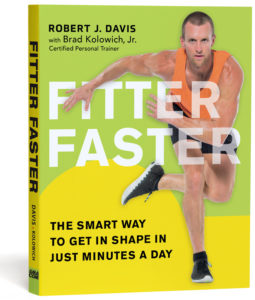
Adapted from http://www.easylivingtoday.com/can-sitting-cancel-out-the-benefits-of-exercise/
We hope you all enjoyed this wonderful article!
Best,
Caroline Kolowich
GIVEAWAY TIME!!!
FITTER FASTER: THE SMART WAY TO GET IN SHAPE IN JUST MINUTES A DAY
Enter the Giveaway for your chance to win FITTER FASTER for free! To enter, click the image below:
Availability: 2 copies available
Giveaway dates: April 13 – May 01, 2017
Countries available: US
Format: Print Book
You don’t want to miss this awesome opportunity to win your copy of FITTER FASTER for FREE! We are so excited to share this amazing book with you all!
Have a great Tuesday!
Spring has sprung and it’s soon swimsuit season. After having eaten your way through winter, you decide it’s time to PANIC. Well, calm down and grab a copy of Fitter Faster by Robert Davis and Brad Kolowich. Here the authors lay out a very doable plan to help
you jump start your fitness regime.
Nothing they suggest you do is cumbersome and they are not judgemental. The authors outline “a smart way to get in shape in just minutes a day.” And no, they do not promise you that you are going to spend 10 minutes a day exercising, and end up looking like a Victoria Secrets model. But they will help you create a plan for yourself so that you can end up healthy, happy, and be the best that you can be.
The authors discuss eating and how to get the most out of your diet. They don’t starve you, but turn you on to foods that benefit your body. They teach the reader how to eat and when to eat.
They discuss that heart muscle and put to rest some old wives tales. They talk about the biggest curse of our era, and that is sitting all day long. They point out how even the simplest change in the way we live our lives can have a lasting beneficial effect and they tell you why.
You are taught the benefits of good gear. The right gear does make a difference. If for nothing else it prevents injury. Listen, having the right sneakers keeps you from hurting your legs, your feet, and very importantly your knees. They take the reader through the latest fads, and discuss what you should and should not buy.
The authors discuss how to make exercising fun as they outline which type of exercise might just be for you. They go through popular forms of cardio with an eye to making sure that you will stick with the program.They help you be realistic in your approach and your goals.
Then in the end, they outline for you beginner, intermediate, and advanced exercise programs from weight training, to cardio, to strength, to the latest HIIT (high intensity interval training) and plyometrics, beginning with that all important stretch. You choose the level you want to work at, as you follow their seven day chart. Don’t worry on the seventh day you get to rest.
If you are a beginner, even if you are advanced, this book will jump start any program and turn your old bored program into something new again.
info@bradkolowichjr.com
KoloFit Training Studio
1465 Chattahoochee Ave.
Suite 800
Atlanta, Ga. 30318

